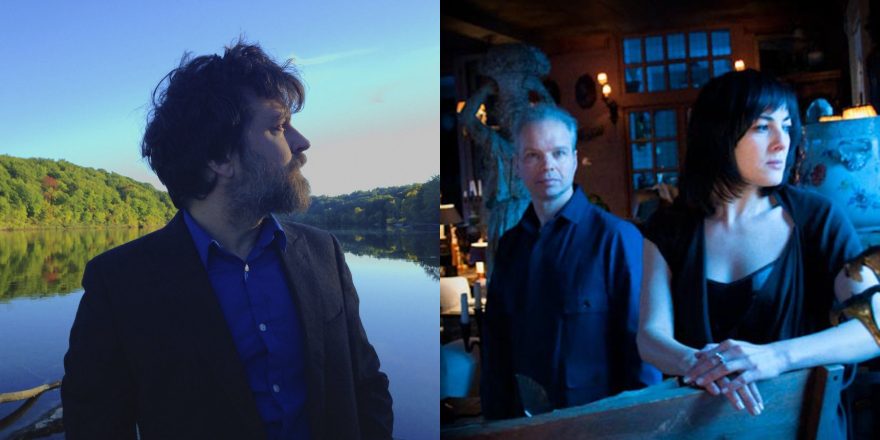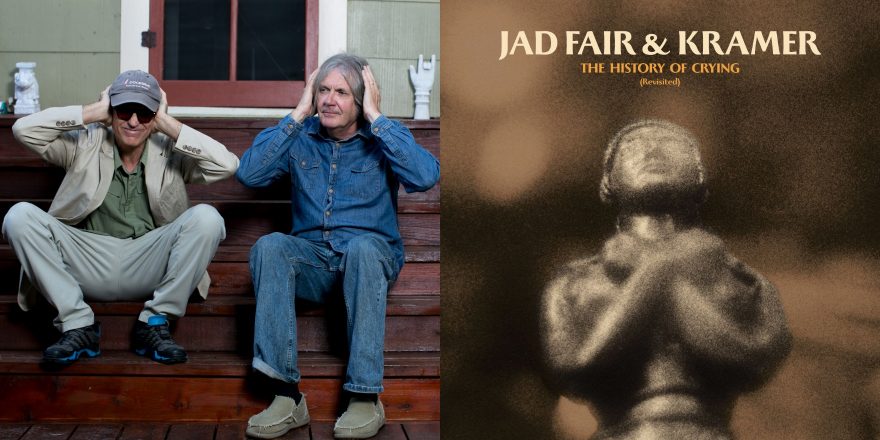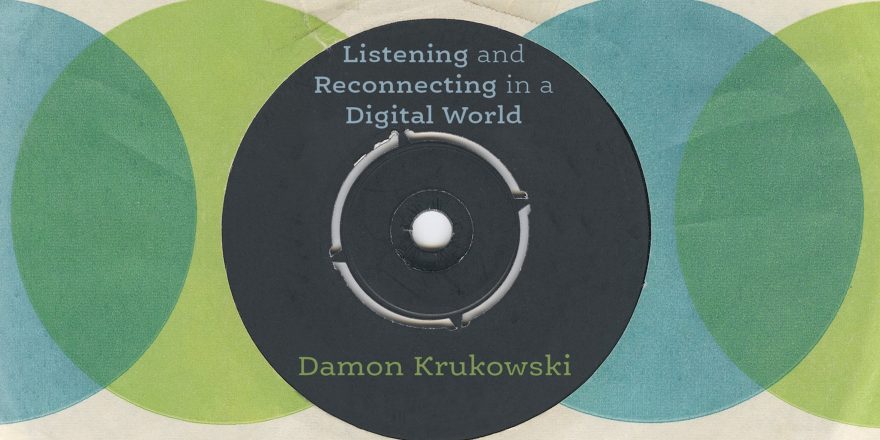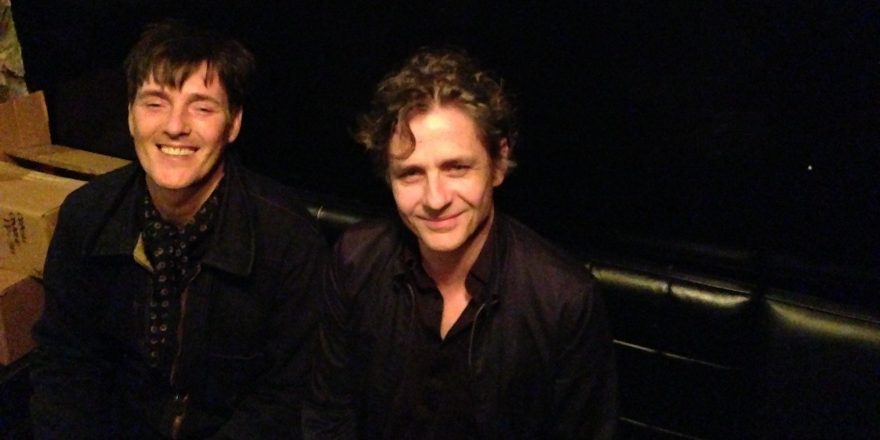Ben Chasny is an indie rock guitarist who performs as Six Organs of Admittance; Damon & Naomi are Damon Krukowski and Naomi Yang, a dream pop duo formerly of the legendary alt rock band Galaxie 500. Both projects have new albums out — The Veiled Sea and A Sky Record, respectively — so to celebrate, the three hopped on a Zoom call to catch up.
— Annie Fell, Editor-in-chief of Talkhouse Music
Damon Krukowski: Your record is beautiful, Ben. It’s got a lot of synths, right? What did you use?
Ben Chasny: Those were all virtual synths. So there’s a company called u-he, which makes a really cool emulation. They do a synth called Zebra that Hans Zimmer used for Blade Runner, actually. They do really nice stuff. So it was mostly that sort of stuff.
Damon: It sounds great. I mean, it just sounds natural for you, but also unexpected in a lot of ways.
Ben: Thank you. I use a program called Reactor a aot, which is a very nerdy kind of program. I wanted to know how you all recorded everything, with the rhythms and everything sounding in time — sometimes there’s no drums in it, but then everything’s in time. How do you manage to do that? I know in the liner notes it talked about figuring out moving to acoustic and keyboards to keep time, but how did you record those?
Damon: We do everything in real time, we have no clicktracks and obviously no drum machines. That was another thing I want to know from you — I couldn’t decide if you were using a drum machine or not on the new record. Is that a drum machine? I can’t tell.
Naomi Yang: He can’t help it, he has so many burning questions. There’s no stopping him!
Ben: There are many secrets, I can’t reveal any more!
Naomi: [Laughs.] We’ve never used clicktracks. And you can tell — I mean, we definitely speed up.
Damon: The time flexes a lot.
Ben: Where did this idea come from, that time has to be precise, anyway?
Damon: I don’t understand it. I think it’s totally a computer thing. I mean, first the click track thing in the pop studios in the ‘70s, and then the computers — I think everything changed when you went to put the music up on the screen and edit on a grid. Because tape — you know how it is, you can’t see anything, so you’re just feeling where going to make a punch or an edit, and there’s no sense of a grid at all.
Naomi: It’s more organic.
Damon: Yeah. And even sort of invisible — time is more mysterious on a tape, I always thought. We don’t have tape at home, but when we were first starting out at Kramer’s studio, tape was just like magic to me. Like this thing was going around, and the time was unspooling from it. And that’s something I never quite got over, that weird feeling of the magic of that.
Naomi: You made a cut, but you sort of had to sort of feel where it was.
Damon: Yeah, totally, and the punch — I don’t know if you remember the feeling of a punch, where you had to kind of get ahead of it, get the head to engage before you needed it.
Naomi: He’s getting very technical.
Damon: Well, anyway, when we started recording at home, we’d use digital tape. But we just didn’t have any other way to think of it, so we’d just do live basic tracks of acoustic guitar and keyboards. And so we put the song down from start to finish that way. We’ll do a couple of takes, choose the best one.
Naomi: Because that’s sort of how, at this point, we’re writing the song. So it does feel sort of like the core of the song.
Ben: You mentioned doing edits on the older songs — were you doing, like, 20-minute jams and then you would cut it down?
Damon: No, we always did just basic tracks — this goes all the way back to Galaxie 500 — live basic tracks, start of the song to the finish of the song. And then everything else was just dealing with punches and overdubs, and things like that. And we still do it that way. We kind of never progressed past that concept of how to construct a recording. But then to get it all in time, what we do is, basically we have to memorize every nuance of the time that’s in the basic track.
Naomi: —Of all our mistakes, basically, in the time. [Laughs.]
Damon: Right. So you choose the basic track, and then you really just have to get it to the point where you can anticipate every —
Naomi: Right before that chorus comes back in, it slows down in some weird way, and then it goes back. So you have to be ready.
Damon: There’s one song on the new record, “The Gift,” which is really the reverse of usual in that the choruses came out slower than the verse. Usually, you know, you sort of speed up into the chorus, and for this song, for whatever reason, we slowed down every chorus, and then the verses pick back up. When I was overdubbing the drums on that — I have to overdub the whole drum kit on top of a basic track—
Ben: That’s what I was curious about — that’s very difficult to do.
Damon: Yeah, it really is difficult to do. The only thing I’ve ever figured out to do is just to memorize it, and you just sort of get this feel. And so this one was like, How the hell do I get a feel where I’ve got to slow down into the chorus? But that’s what I did. And then I overdubbed percussion on those choruses, partly because the time felt so, kind of like you went underwater or something all of a sudden. So I felt like I wanted it to pass through some medium as you, like, plunge into this slightly slower chorus. So I added a bunch of bells on top of it. But I can’t play the drums until Naomi’s bass is down — it’s all upside down. So we do the basic tracks live, then Naomi adds bass, then I can add drums.
Naomi: So I have to memorize the song first.
Damon: Because I have to listen to her bass to play the drums, and then I can make the drums feel live because I’m following her bass. And that’s how we do it. This record was unusual in that we had this opportunity to record [guitarist Michio] Kurihara before kind of everything. So he had to go down straight onto the pretty raw, basic tracks.
Naomi: Except for the keyboard.
Damon: Keyboard and an acoustic guitar.
Naomi: But we did have the melodies, because that’s one thing that Kurihara always wants to know before he puts anything down, like, “Well, what’s the melody? What’s the singing going to be? Where’s the singing going to be and what’s it going to be?” Because he’s so sensitive about not wanting to step on top of it. And, you know, in the normal course of doing a guitar solo’s textures, you would be able to know the singing and where it was going. So we had to have that really prepared, even though we didn’t have the lyrics.
Damon: Right, so we put guide vocals down for him.
Ben: I love how detailed Kurihara got in the liner notes.
Naomi: Right?
Ben: One of the coolest things about this release is that booklet. To me, to release a record right now — not just because of the overall COVID thing, but record plants being so backed up, streaming being so ridiculous — I don’t know if you know about that, Damon.
Damon: [Laughs.] I’ve heard, it’s kind of fucked up!
Ben: [Laughs.] But what I loved is that you came together with your combined forces and talents — graphic design and photography and writing — and you made this thing that exists not because of the time, but despite it. And one of the things, as well, is all the friends that you have, and they’re tying everything together this glue. I thought it was a really cool move.
Naomi: Thank you. It made us really happy, and I’m so glad that you can enjoy all those aspects to it. It really was a fun thing to put together, and it came out of the fact that it just seems so frustrating to finish a record and have it, like, not exist. Like it’s just in the air, and to have there be nothing physical.
We were talking about the whole issue with the pressing plants and how hard it is, and Damon was telling me some background of why they’re so backed up and why it’s so hard to make vinyl. And I was just saying like, “But that’s not the problem. There other types of presses, other printers are fine in the world!” And then sort of at that moment — “We could print something else! You you can print a book or a pamphlet and there’s no huge, crazy line, you just send it out and it comes back.” And it was sort of like, “Oh, well, then let’s make something physical.” And then, you know, the whole history of liner notes, and the enjoyment that you have, if you’re enjoying a record, to look more closely at how it was made by reading the liner notes.
Damon: Yeah. The funny thing is, we got to do a much more lavish type of liner notes than we could have if we were pressing an LP.
Naomi: Yeah. We would have never been like, “We need a 48-page booklet in our LP.”
Damon: It was sort of like it was straight to boxset, like skipping the original release. But you drop the vinyl out, it cost us about the same as manufacturing vinyl.
Naomi: I’m so glad you picked up on all the friendships, because that collaboration is so important to us and something that we really cherish. And, of course, you know, putting that book together after this whole pandemic and being in isolation from touring and from being with friends for so long, it was really joyous to be able to do that.
Ben: You mentioned Sky Records in the liner notes, and this being the inspiration for your record. I was curious about the label, and I was curious why then, this label in particular, you found inspiring. Because it sounds like it’s people you knew from other projects, right?
Damon: Yeah, exactly. So Sky is mostly instrumental records by a bunch of people in bands that you know — Michael Rother from Neu!, Jaki Liebezeit from Can, and the two guys from Harmonia and Cluster. Conny Plank did a lot of the engineering, Brian Eno collaborated on some of those records. But they were all made in the countryside after all those guys had sort of moved out of Cologne and Berlin in the ‘70s. So there’s sort of like, back-to-the-land — very kind of like where you are right now, like, “I’m not in San Francisco, I am in California in the countryside more.” And that’s what they did, Conny Plank built a studio on the countryside, and that’s where most of that stuff was done. So they’re sort of bucolic, but at the same time, you’ve got all these, like, anxious German rock guys, so they’re not really bucolic, you know what I mean?
Naomi: But there is sort of a calmness to them. But that was something that we really enjoyed, because it was different from the sort of propulsion of krautrock.
Damon: They’re relaxed.
Naomi: It felt very nourishing to be listening to those records so often — [they were] albums that did not leave our turntable. We were very, very deeply into them, where you had to sort of hear them every night. Which is always a joy, when you find music that you hadn’t heard before that you just completely can sink into. And so it’s funny, because it was in a way like all those musicians are sort of old friends — not literally, but in terms of musically — but it was a different take on them. We knew all their other music, but these records on Sky Records, we’d never heard of at all. It was kind of wonderful to discover it.
Ben: You discovered them when you were on tour? Did you just see one, or did someone tell you [about them]?
Damon: Yeah, it was in Berlin. They’re really plentiful there, in the flea markets and the used record stores; they’re everywhere, all over Berlin, like the records you’d pass over because they’re so common. They were literally in, like, dollar bins. One or two are pricey, and those have sort of been reissued, like the Eno ones. But the others were just literally like — you know how every local place has it, like here in Cambridge, all the Jim Kweskin albums are always here for a dollar, and then I’ve seen them at Amoeba for, like, $25. So I was just I just was like, Jeez, I never heard these records, with Jaki Liebezeit on them! So I just bought them all, you know, like every one I could find in a weekend in Berlin, and brought them home.
Ones I think you’d really love are the Michael Rother — there are three in particular that are so beautiful, Katzenmusik, Sterntaler, and Flammende Herzen. They’re all a little romantic. Like, “katzenmusik” means “cat music,” but it also means rough music, like banging on pots and pans for a wedding. And “flammende herzen” is “flaming hearts” — I mean, come on, it’s real soft and and sentimental feeling.
Naomi: But “flaming hearts” has a little edge to it.
Damon: It has a little edge, but it has hearts on the cover. And it’s just him and Jaki Kiebezeit as a duo, basically, like drums and electric guitar. Really spare.
Naomi: The provisional name [for the album] was A Sky Record, because we were saying we wanted to be as if it would have been something in their catalog. And then we just kept the name. But it was sort of the provisional mood of the album.
Damon: Yeah, it was kind of a working title, actually, but I was really into it from the beginning.
Ben: Is that something you’ve done before, where you have a pinpoint of a framework that you’re kind of working towards, even if it’s an abstract thing?
Damon: I feel like we always kind of pick something —
Naomi: We always sort of have something to hang your hat on. It’s a way, I think, of saying where you want to go with your music or your songwriting. It’s hard, because maybe other people can’t hear the difference, but the structure is something that helps you focus what you’re trying to do.
Damon: Yeah, sometimes it’s just a simple thing like, “We’re going to have horns this time.”
Naomi: But even then, we were listening to Frank Sinatra and to things with big orchestration, so it wasn’t just horns. You had sort of an idea of, “Well, what would it be like to make a record that had this framework?”
Damon: Yeah, that’s true. Sometimes we give ourselves pretty tall orders. The album Within These Walls, which is what Naomi’s talking about, we we were challenging ourselves, “Could we play as slow as Sinatra? Could we make that kind of ballad record? Could people think we’re slow?”
Ben: Oh, that’s good, because normally when people think of your music, they think of extremely fast kind of stuff.
Damon: [Laughs.] “What happens when you slow us down?” No, but what happens is we, like, slow down off people’s charts. That was a hard sell, that record, because we had played slow for us, which was like, “Where are we now?
Ben: It’s interesting that you find these frameworks as well, because I think some bands have that idea, “Maybe we’ll do something like this.” But it seems like there’s a misconception when it comes to an artist and a collection of more song-oriented stuff, that it’s merely a collection of songs — there’s sort of this idea that maybe a songwriter is just going in and writing a song or whatever is inspiring them for the day, and playing it, and then, Oh, I have 12 or 13 songs, I think I’ll collect them into album.
Naomi: Right. Well, I think some people definitely do that, people who put out records much more often. We write so many riffs and not full songs, but we’re pretty harsh about what we actually end up keeping. I think many people do just make a record that way, and that’s why they can be much more prolific.
Damon: Yeah. But your records more obviously seem like you always have a very solid idea of what ties this album together or this.
Naomi: Yeah, you have a whole system.
Damon: Which brings up another question I want to ask you. This album is not hexadic, right? You didn’t use it at all?
Ben: No, not hexadic.
Damon: So did you feel like there was another system that you used to replace that for yourself on this album?
Ben: What I was trying to do was take from Companion Rises, and that was going in a certain direction. And I never do this with records, but this one is actually supposed to be an extension from the last one.
Damon: Oh, right! Gosh, they sound really different to me.
Ben: Normally what I try to do is kind of go opposite from what the last one was, not just to be a contrarian, but I just get bored. Usually that idea’s done, so being a one-man band, it’s very easy. There’s no arguing what I should do — if there is, there’s real problems.
Naomi: I have lots of arguments in my head with things that I do alone though, so. [Laughs.]
Damon: So you mean the percussion at the opening of the album is actually programmed?
Ben: Most of that stuff is programmed. That was kind of weird four-track collage kind of stuff — I program some stuff and bump it onto the four-track, and put it back, so it was kind of a back and forth thing.
Damon: Yeah, because I could not figure out how you did that percussion thing at the beginning of the album.
Ben: Yeah, those are little tape collages.
Are you working on any projects right now?
Naomi: We’re working on one project right now, but I don’t really want to—
Ben: Yeah, I understand.
Naomi: [Laughs.] It’s like the jinx. :et’s just have all our fingers crossed, fingers, toes.
Ben: What was the first Exact Change book that you guys did?
Naomi: The first was the fanzine.
Damon: We had a zine in college together called Exact Change. That’s where the name came from.
Ben: Oh, I didn’t know that.
Naomi: But it wasn’t a zine like you’re thinking, because it had nothing to do with music.
Damon: It was a landscape zine.
Naomi: Yes, it was a journal of the American landscape, which meant anything.
Damon: It was a zine about the landscape.
Naomi: It’s closer to our companion — it was writing about the landscape, as well as poetry, photographs, essays by our friends that didn’t specifically have to do with landscape per se, but had to do with, you know, America. Like a friend wrote about growing up in his grandfather and grandmother’s diner in Ithaca. So it was just an eccentric collection, sort of literary. And there were only two issues.
Damon: And then what happened was, I was taking poetry classes with Charles Simic at University of New Hampshire — it was a state school, so I could just pay for the credit and take his class; I was getting my degree here, but I could just drive up there and take his poetry class. And I gave him the zine and he really liked it, and his response was to give us a bunch of poems and said, “Do you want to make a chapbook for me?” So that was the first Exact Change book, a book of his poems. And then we just kept going.
Naomi: And then Damon was in graduate school, and all our friends were reissuing records on labels that they were starting, or putting out records. And there were all these books of literature that were out of print and really hard to find and — you know, pre-internet — not only could you not find a copy, but there was no resource online where you could just read it without having a copy. And we were like, “Well, what if we reprint this the way our friends are reissuing records?” So that was our very non-business plan, but it was kind of in the spirit of sharing these great things.
Damon: The one [Rene] Daumal book, was one of the first ideas of what to publish, and we couldn’t get the rights for decades, literally decades. And finally it went into public domain. [Laughs.] We waited so long, we got so old, the text we couldn’t license went into the public domain.
Ben: Perfect.
Damon: You just gotta wait it out. It’s the same in music — I feel like you’ve done this too — you keep going, and there are moments when it all connects and everything works. And then there are moments when it’s really frustrating and it doesn’t, but you keep doing it and somehow things work out. And then it looks like a plan, but it wasn’t a plan.








